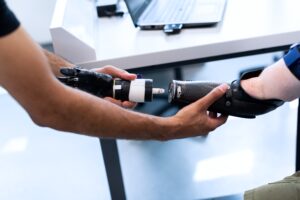 Appearance, functionality or both? That is the question … right?
Appearance, functionality or both? That is the question … right?
While your ‘ideal’ is to most likely not be having this conversation at all (and trust me, we get that!), our expert prosthetists will outline all of your options so you can make the choice that’s right for you.
Myoelectric prosthetics, such as the i-limb, are an attempt to serve both purposes of an artificial limb equally without sacrificing appearance for functionality.
But maybe speed, strength and dexterity factors outweigh your desire for the latest cosmetic “makeover”. Farmers, maintenance workers, chefs, administrative professionals and parents know this well. So, perhaps, body-powered prosthetics may functionally serve you best.
Eager to simply brush your teeth, cook an egg, garden, operate a machine or attend a job fair without fear of limitation?
Regardless of your needs, occupation, and recreational activities, Prosthetix Shop can help!
When an individual loses an arm or a hand, they may require prosthetic devices in order to perform basic activities of daily living, whether for recreational or vocational purposes. With the proper type and fit, the right prosthetic device can greatly improve quality of life for people who have lost an upper limb.
Upper limb difference can be the result of various medical conditions or injuries. Trauma, vascular complications of disease, and cancer are the most common reasons for upper limb amputation. In civilians, the most common cause of trauma is work-related injuries. Additionally, improvised explosive devices (IEDs) are the most common cause of combat-related injuries among military personnel.
At the time of prescription, the prosthetist works with the patient and a rehabilitation team to ensure the best upper limb prostheses for the individual’s goals. The terminal device (TD), interposing joints, socket, suspension, and control system are all important components of upper limb prostheses that can be customized to fit individual needs.
Additionally, there are many different types of upper limb prosthetic devices available, depending on the needs of the individual. Upper limb prostheses can be used for general purpose or for specific tasks. General purpose prostheses can be used for a variety of purposes, such as lifting an object with a prosthetic hook or holding a cup with a prosthetic hand. Task-specific prostheses can be custom made to achieve specific tasks, such as writing with a prosthetic pen grip, painting with a prosthetic brush hook, or weightlifting.
A comprehensive assessment by our professional team can help in determining the type of upper limb device to be prescribed and the amount of prosthetic training required.
5 Types of Upper Limb Prostheses
- Passive prostheses
- Body-powered prostheses
- Externally powered myoelectric prostheses
- Hybrid prostheses
- Activity-specific prostheses
Passive Prostheses
Balance, object stabilization (such as holding down paper when writing), recreational as well as vocational activities are all aided by passive prostheses. They have the most realistic appearance and are the lightest and usually the most affordable, but they do not allow active hand and joint mobility.
Body-powered Prostheses
Because they are less expensive, tend to last longer, and require less care, body-powered prostheses are the most frequently used prostheses by people who mostly do physical labor. This type of prosthetic device is held in place by a strap-cable system that operates the hook, hand, and/or elbow joint using the movements of the person’s shoulder blade and upper arm.
In some systems, the opposite arm is used to trigger one specific function – one end of a strap encircles the opposite arm at the armpit, and the other end connects to a cable that controls the terminal device (hook, hand, or specialty device for a particular function).
Externally-powered Myoelectric Prostheses
For an individual requiring active hand and joint movement without the need for shoulder or torso movement, externally-powered myoelectric prostheses would be the ideal option.
Electrically powered actuators give more grab force than body-powered prostheses, controlled by sensors and other inputs that use muscular movement of the residual limb or upper torso.
Hybrid Prostheses
For higher level upper-limb amputations, hybrid prostheses are typically used. This type of prostheses combines the body’s physical strength with myoelectric power to aid movement. A body-powered elbow, for example, might be used in conjunction with an externally powered hand or terminal device.
Activity-specific Prostheses
These prosthetic devices are used most commonly by individuals who engage in activities that could harm their residual limb or everyday prosthesis, or when the everyday prosthesis is ineffective.
Activity-specific prostheses often use a specialty design interface, suspension system, socket, and terminal device. These devices can help the individual using them to grasp specific tools such as a hammer, baseball bat, golf club, or hold a baseball glove. There are also devices of this kind that can assist a variety of vigorous activities, such as swimming, skiing, or fishing. Activity-specific prostheses can be operated by the individual, or they can also be passive.
Contact Us
Here at Prosthetix Shop, we aim to provide effective prosthetic devices and solutions for all types of upper limb deficiencies. If you have any questions about upper limb prosthetic devices, call us today in the greater Cincinnati, Ohio tri-state area at (513) 843-5126 or (859) 440-3178 for Northern Kentucky, or call (614) 500-4215 for Columbus, Ohio. You can also visit our Contact Page to send us a message. We would be happy to assist you and provide the best prosthetic arm and/or hand for your needs.
